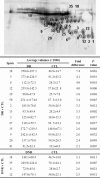Advanced glycation end product (AGE) modified proteins in tears of diabetic patients
- PMID: 20806041
- PMCID: PMC2927418
Advanced glycation end product (AGE) modified proteins in tears of diabetic patients
Abstract
Purpose: High glucose level in diabetic patients may lead to advanced glycation end product (AGE) modified proteins. This study investigated AGE modified proteins in tears and compared their levels in diabetic patients (DM) with non-diabetic controls (CTL).
Methods: Basal tears were collected from DM with (DR) or without (DNR) retinopathy and CTL. Total AGE modified proteins were detected quantitatively by a dot immunobinding assay. The AGE modified proteins were separated in 1D- and 2D-SDS gels and detected by western-blotting. The individual AGE modified proteins were also compared between groups using densitometry.
Results: Compared with the CTL group, tear concentrations of AGE modified proteins were significantly elevated in DR and DNR groups. The concentration of AGE modified proteins in diabetic tears were positively correlated with AGE modified hemoglobin (HbA1c) and postprandial blood glucose level (PBG). Western blotting of AGE modified proteins from 1D-SDS gels showed several bands, the major one at around 60 kDa. The intensities of AGE modified protein bands were higher in DM tears than in CTL tears. Western blotting from 2D-SDS gels showed a strongly stained horizontal strip, which corresponded to the major band in 1D-SDS gels. Most of the other AGE modified protein species were within molecular weight of 30-60 kDa, PI 5.2-7.0. Densitometry analysis demonstrated several AGE modified proteins were elevated in DR or DNR tears.
Conclusions: Total and some individual AGE modified proteins were elevated in DM tears. AGE modified proteins in tears may be used as biomarkers to diagnose diabetes and/or diabetic retinopathy.
Figures





Similar articles
-
Apolipoprotein A-I concentration in tears in diabetic retinopathy.Ann Clin Biochem. 2002 Jan;39(Pt 1):56-61. doi: 10.1258/0004563021901748. Ann Clin Biochem. 2002. PMID: 11853190
-
Serum and tear levels of nerve growth factor in diabetic retinopathy patients.Am J Ophthalmol. 2008 Mar;145(3):432-7. doi: 10.1016/j.ajo.2007.11.011. Am J Ophthalmol. 2008. PMID: 18282491
-
Comparison of camel tear proteins between summer and winter.Mol Vis. 2011 Feb 1;17:323-31. Mol Vis. 2011. PMID: 21293736 Free PMC article.
-
Diabetic retinopathy: Proteomic approaches to help the differential diagnosis and to understand the underlying molecular mechanisms.J Proteomics. 2017 Jan 6;150:351-358. doi: 10.1016/j.jprot.2016.06.034. Epub 2016 Jul 1. J Proteomics. 2017. PMID: 27373871 Review.
-
Glycation in diabetes: is it the same in all patients?Cas Lek Cesk. 2024;163(5):185-188. Cas Lek Cesk. 2024. PMID: 39516019 Review. English.
Cited by
-
Advanced glycation end products induce human corneal epithelial cells apoptosis through generation of reactive oxygen species and activation of JNK and p38 MAPK pathways.PLoS One. 2013 Jun 12;8(6):e66781. doi: 10.1371/journal.pone.0066781. Print 2013. PLoS One. 2013. PMID: 23776698 Free PMC article.
-
Luteolin alleviates methylglyoxal-induced cytotoxicity in osteoblastic MC3T3-E1 cells.Cytotechnology. 2016 Dec;68(6):2539-2552. doi: 10.1007/s10616-016-9977-y. Epub 2016 May 24. Cytotechnology. 2016. PMID: 27221336 Free PMC article.
-
An Update on Corneal Biomechanics and Architecture in Diabetes.J Ophthalmol. 2019 Jun 2;2019:7645352. doi: 10.1155/2019/7645352. eCollection 2019. J Ophthalmol. 2019. PMID: 31275634 Free PMC article. Review.
-
UV Fluorescence-Based Determination of Urinary Advanced Glycation End Products in Patients with Chronic Kidney Disease.Diagnostics (Basel). 2020 Jan 9;10(1):34. doi: 10.3390/diagnostics10010034. Diagnostics (Basel). 2020. PMID: 31936498 Free PMC article.
-
Gp130 Promotes Inflammation via the STAT3/JAK2 Pathway in Allergic Conjunctivitis.Invest Ophthalmol Vis Sci. 2023 Apr 3;64(4):5. doi: 10.1167/iovs.64.4.5. Invest Ophthalmol Vis Sci. 2023. PMID: 37022703 Free PMC article.
References
-
- Tiffany JM. The normal tear film. Dev Ophthalmol. 2008;41:1–20. - PubMed
-
- Holly FJ. Tear film physiology. Int Ophthalmol Clin. 1987;27:2–6. - PubMed
-
- Tiffany JM. Composition and biophysical properties of the tear film: knowledge and uncertainty. Adv Exp Med Biol. 1994;350:231–8. - PubMed
-
- Bron AJ, Tiffany JM, Gouveia SM, Yokoi N, Voon LW. Functional aspects of the tear film lipid layer. Exp Eye Res. 2004;78:347–60. - PubMed
-
- Craig JP, Tomlinson A. Importance of the lipid layer in human tear film stability and evaporation. Optom Vis Sci. 1997;74:8–13. - PubMed
Publication types
MeSH terms
Substances
LinkOut - more resources
Full Text Sources
Medical
Research Materials
Miscellaneous
